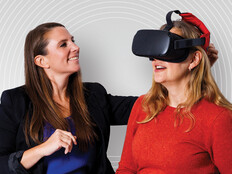Virtual Reality Coursework Provides Rich Training Ground
There’s a tipping point at which we stop referring to innovations as “emerging” and simply say, “They’re here.” We are rapidly approaching that point with virtual and augmented reality (some would say we passed it last summer, with the explosive popularity of Pokémon Go). In any case, it’s fun and intriguing to see the variety of VR/AR applications that students and professors are coming up with.
IDC forecasts that global sales of VR headsets will jump to 61 million by 2020, up from 10.1 million in 2016. As adoption ramps up, demand for applications will be fast on its heels, and professionals trained in all aspects of VR will be in hot demand. Institutions across the country are stepping up to help students get ready.
Virtual Environments Are A New Approach to Hands-On Training
At Southwest Virginia Community College, students in the Crime Scene Technology program are using augmented reality to learn about crime scene investigations. Their tool is a game developed for the Microsoft HoloLens, Fragments, which puts the user in the role of the “detective.” In this virtual environment, students can practice the skills they’ll eventually use on the job.
And at Pennsylvania State University, professors in the agriculture program are creating a VR-based lesson that will take students on “crop walks,” an established technique for teaching students to identify plant diseases. The advantage of VR, of course, is that it’s available year-round, whereas in-person walks are possible only in certain seasons.
These types of real-world training are exactly the kind of VR/AR applications that may prove to be most valuable in higher education. Several medical schools, for example, are using VR to help students master the complexities of human anatomy and practice delicate operations, such as cataract surgery, on virtual patients. In this setting, VR gives students ample opportunities to hone their skills in a risk-free environment. Faculty members say tools like the Anatomage Table — a virtual dissection table and digital cadaver — are incredibly engaging to students.
When it comes to training future doctors, VR gives students another valuable lesson: the ability to put themselves first-hand into another’s experience. For example, students learning about geriatric care can use an Oculus Rift system and specialized software to learn what it’s like to be an older adult, insights that can help them be more empathic caregivers.
In New York, Lehman College is creating an Interactive Digital Center that will train future VR/AR professionals and support the development of new learning applications for students. The center’s hands-on program will include both classroom work and projects for actual customers.
VR Creates a New Art Form
Preparing students for the workforce of tomorrow is an important benefit of VR curricula, but educators also point to the ways that VR can deliver enriching experiences. The fact that VR is relatively affordable — and becoming more so all the time — means more students can have access to experiences that otherwise might be out of reach. Think international travel and study abroad, with their rich exposure to new cultures, natural wonders, works of art and foreign languages.
VR also expands the realm of possibility for students interested in creativity and problem solving. Colleges are already offering courses dedicated to VR technology, in which students create films, interactive games, campus tours and even customized projects for real-world clients. As one educator has noted, VR amounts to a new art form: both a new way to tell stories and an entirely new professional field.
VR is exciting not only because it is new, but also because it is limited only by the imagination. Students and faculty who engage with these applications talk about their work as if they are pioneers in an unexplored landscape, which, in a very real sense, they are. We are only at the beginning of the journey.
This article is part of EdTech: Focus on Higher Education’s UniversITy blog series.










